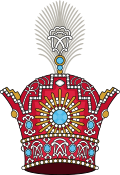Rana (title)
Rana Pratap Singh
, a Sisodia Rajput ruler of the 16th century.
Rana (
Sanskrit: राणा) is a historical title denoting an absolute Hindu monarch[1] in the Indian subcontinent. Today, it is used as a hereditary name in the Indian subcontinent. "Rana" was formerly used as a title of martial sovereignty by Rajput kings in India.[2] Rani is the title for the wife of a rana or a female monarch. It also applies to the wife of a raja. Compound titles include rana sahib, ranaji, raj rana, rana bahadur, and maharana
.
Usage in the Indian subcontinent


"Rana" was formerly used as a title of martial
Amarkot, a state in Sindh, has a Hindu Thakur Sodha Rajput ruler who uses the title.[5]
In the 16th century,
Amarkot, gave refuge to the Mughal prince Humayun and his wife, Hamida Banu Begum, who had fled from military defeat at the hands of Sher Shah Suri. Their son Akbar was born in the fort of the Rana of Amarkot.[6]
Shree Teen
Maharaj Jung Bahadur Kunwar Ranaji at London in 1850The head of the Kunwar nobles of Nepal,
As a title
- The Kolis of India used the title of Rana and ruled over Princely State of Shevdivadar[9] and Sinhagad fort was ruled by Koli Rana Nag Nayak who challenged the Delhi sultanate's Sultan Muhammad bin Tughluq.[10][11]
| Part of a series on |
| Imperial, royal, noble, gentry and chivalric ranks in West, Central, South Asia and North Africa |
|---|
 |
|
|
- The Rana is a title used by different Rajput clans across India, Pakistan and Nepal. In India and Nepal, they are predominantly Hindus.[12][13][14]
Rana rule in Nepal
The Rana rule in Nepal from the mid-1800s to the mid-1900s saw a whole century of oppression of Nepalese who became Buddhist monks. The first victims were Nepalese Mahayana (Tibetans) who converted to Buddhism, then Theravada Buddhism in the "History of Theravada Buddhism in Nepal" to stop their discriminatory practices.[15]
Dress
Dress varies from region to region. Historically, traditional Indian clothing was worn.[citation needed]
References
- ^ Sandeep Sinha (2021). I Wasn't Born For This. BFC Publications. p. 94.
- ^ ISBN 9781438105239.
- ISBN 978-1-4497-0061-4.
- ^ "Rajput appeal from Amarkot". The News International, Pakistan. 24 July 2013. Retrieved 10 September 2015.
- ^ P B Chandra (10 August 2009). "Rana kin in Pakistan for mourning". The Times of India. Retrieved 5 September 2021.
- ^ "Umerkot's former Rajput ruler is dead". The Hindu. Retrieved 5 September 2021.
- ^ Dietrich, Angela (1996). "Buddhist Monks and Rana Rulers: A History of Persecution". Buddhist Himalaya: A Journal of Nagarjuna Institute of Exact Methods. Retrieved 5 September 2021.
- ^ Lal, C. K. (16 February 2001). "The Rana resonance". Nepali Times. Retrieved 5 September 2021.
- ISBN 978-81-87879-54-1.
- ^ Kale, Rohit Pralhadrao (24 May 2018). Rajwata: Aavishkar Gad Killayacha. New Delhi, India, Asia: FSP Media Publications. pp. Sinhagad was captured from the Koli tribal chieftain, Nag Naik, by Muhammad bin Tughlaq in 1328 AD. Shahaji Bhosale, as the commander of Ibrahim Adil Shah I, was entrusted with the control of the Pune region. His son Shivaji, however.
- ISBN 978-81-207-0573-9.
- ISBN 978-0-19-563354-2.
- ISBN 978-1-4381-0523-9.
- ^ توصیف الحسن میواتی الہندی (23 August 2020). تاریخِ میو اور داستانِ میوات.
- ^ "Buddhist Monks and Rana Rulers". ccbs.ntu.edu.tw. Retrieved 3 July 2020.
